Is It Safe to Eat Raw Ramen Noodles
You can safely eat raw instant ramen noodles, as they're pre-cooked during manufacturing. However, it's not the healthiest choice. Raw ramen is calorie-dense, high in sodium, and offers limited nutritional value. It may also be harder to digest, potentially causing discomfort. Fresh ramen, on the other hand, should always be cooked before consumption due to its higher moisture content and risk of bacterial contamination. While raw instant ramen has become a popular snack trend, it's best consumed in moderation. Consider alternative preparation methods or healthier options if you're looking for a quick, crunchy snack. Exploring further will reveal more about the nutritional implications and best practices for consuming raw ramen.
This post may contain affiliate links. If you make a purchase through these links, I may earn a commission at no additional cost to you. Additionally, portions of this post may be generated using artificial intelligence (AI) technology. While we strive for accuracy, please be aware that AI-generated content may not always be perfect and should be fact-checked when necessary.
The Spatula Scoops
- Instant ramen noodles are pre-cooked and safe to eat raw from an unopened package.
- Raw ramen is generally safe but may be harder to digest and less nutritious than cooked ramen.
- Consuming raw ramen can lead to higher sodium intake due to concentrated seasoning packets.
- Fresh ramen should always be boiled before eating to ensure safety and avoid potential bacterial contamination.
- Eating raw ramen occasionally is okay, but it shouldn't be a regular dietary staple due to limited nutritional value.
Raw Ramen: Safe or Risky?
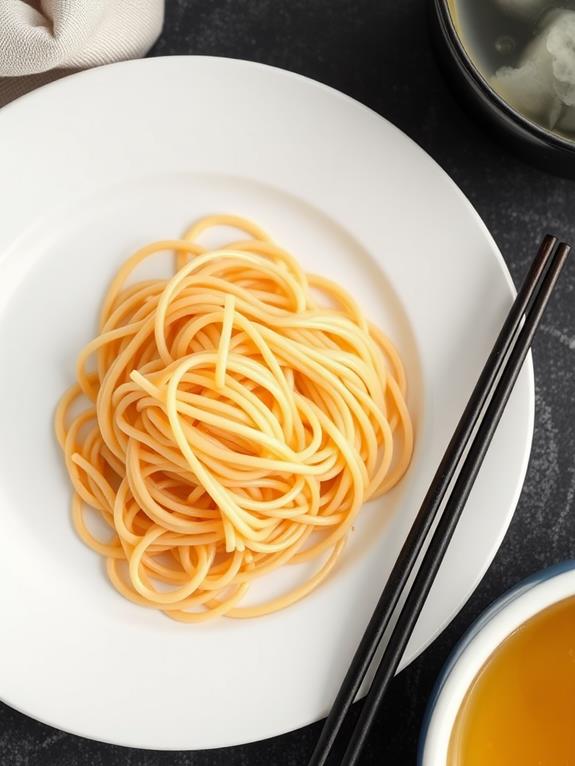
When it comes to raw ramen, you're not taking as big a risk as you might think. The noodles you find in those instant ramen packages are actually pre-cooked during production, making them safe to eat straight out of the bag. However, there are a few things you should keep in mind if you're planning to eat raw ramen.
First, it's best to consume the noodles directly from an unopened package. This practice helps avoid any potential moisture contamination that could lead to bacterial growth. While eating raw ramen can be a crunchy snack, it's important to remember that uncooked noodles may be harder to digest, especially if you eat large quantities. In some cultures, like South Korea, raw ramen is even marketed as a snack food, showcasing its acceptance and safety for consumption.
That being said, you should still be cautious about storage practices after opening the package. Proper handling is essential to prevent bacterial contamination. Additionally, keep in mind that raw ramen tends to have a higher calorie density compared to its cooked counterpart, making it less suitable as a regular dietary staple due to its limited nutritional value.
Understanding Instant Noodle Production
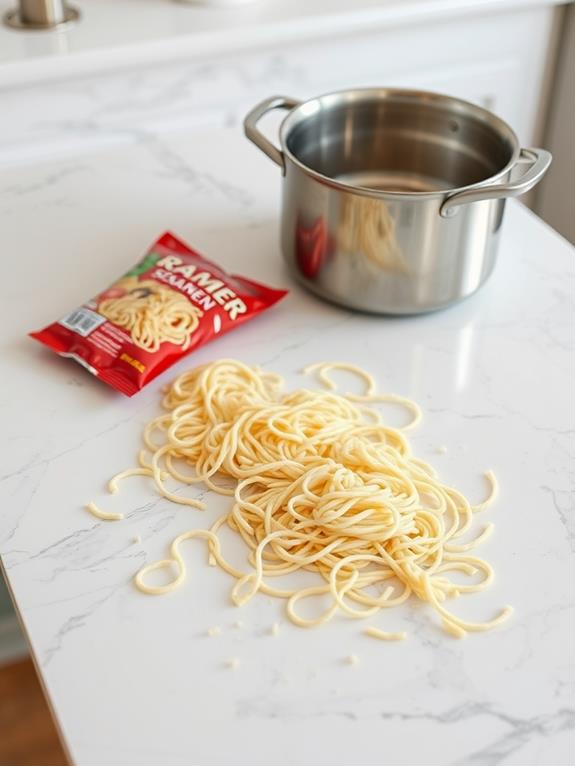
The journey of instant ramen from raw ingredients to shelf-stable snack is a fascinating process. You might be surprised to learn that instant ramen noodles are made with just four main ingredients: flour, water, salt, and kansui. This alkaline solution gives the noodles their unique texture and flavor.
The production of instant ramen noodles involves several key steps:
| Stage | Process | Purpose |
|---|---|---|
| Mixing | Kneading ingredients | Create elastic dough |
| Cooking | Steaming | Guarantee safety and quality |
| Dehydration | Deep frying or blow drying | Reduce moisture content |
| Packaging | Sealing in airtight containers | Maintain shelf stability |
During production, the dough is first kneaded to achieve the right elasticity. It's then steamed to cook the noodles partially. The essential dehydration step follows, where the noodles are either deep-fried or blow-dried to remove moisture, greatly extending their shelf life. Finally, they're packaged to protect them from moisture and contamination.
This process results in a pre-cooked, dehydrated product that's safe to eat raw, much like jerky. The absence of perishable ingredients and the thorough cooking and drying processes guarantee that your instant ramen noodles remain safe and tasty, whether you choose to cook them or munch on them straight from the package.
Fresh vs. Instant Ramen
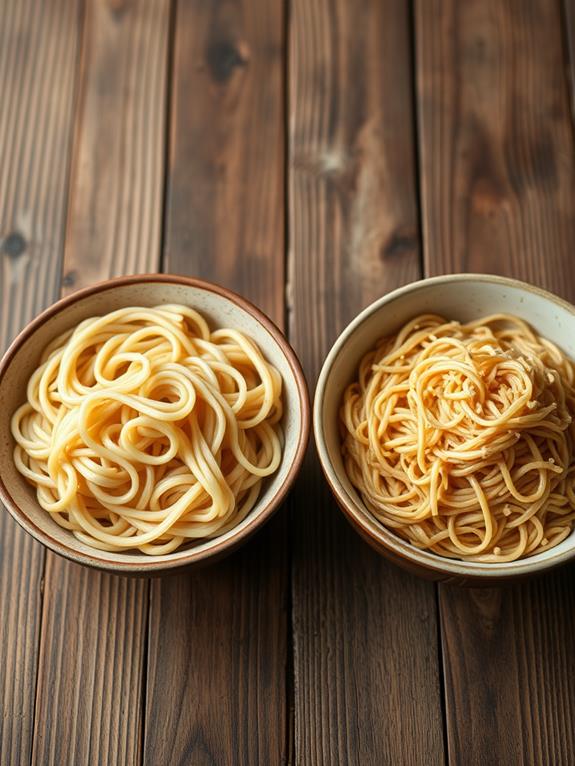
When comparing fresh and instant ramen, you'll find significant differences in preparation and safety considerations. Fresh ramen noodles require cooking to guarantee they're safe to eat, as they can harbor bacteria due to their moisture content, similar to how expired tofu poses food safety risks. In contrast, instant ramen noodles are pre-cooked and dehydrated, making them safe to consume raw, though they're typically designed to be prepared with hot water.
Preparation Differences
Fundamentally, fresh and instant ramen differ in their preparation methods, which greatly impacts their safety for raw consumption. When you're considering eating raw instant ramen, you'll be pleased to know it's already been pre-cooked during production. This process involves steaming and dehydrating the noodles, making them shelf-stable and safe to eat without further cooking.
On the other hand, fresh ramen hasn't undergone this treatment. It retains its moisture and is considered raw, requiring boiling before you can safely consume it. Let's compare the key differences:
| Aspect | Fresh Ramen | Instant Ramen |
|---|---|---|
| Cooking | Requires boiling | Pre-cooked |
| Moisture | High content | Dehydrated |
| Texture when raw | Chewy, unappealing | Crunchy |
The ingredients also differ between the two types. Instant ramen typically contains flour, water, salt, and kansui, while fresh ramen often includes additional proteins like wheat gluten. This composition affects not only the taste but also the safety of raw consumption. Eating raw fresh ramen poses health risks due to potential bacterial contamination, whereas raw instant ramen is designed to be safe when properly packaged.
Safety Considerations
In light of the preparation differences, safety considerations for consuming raw ramen vary considerably between fresh and instant varieties. When it comes to instant ramen, you'll be relieved to know that it's safe to eat straight from the package. These noodles have been pre-cooked and dehydrated, eliminating any potential health risks. However, fresh ramen is a different story. Since it retains moisture and is considered raw, eating it uncooked can pose serious health risks due to possible bacterial contamination.
To guarantee your safety when enjoying ramen, consider the following:
- Always boil fresh ramen noodles before consuming
- Instant ramen can be eaten raw, but it's more flavorful when cooked
- Be cautious of raw dough-like textures in fresh ramen, as they may indicate undercooking
While you might be tempted to crunch on some uncooked instant ramen for a quick snack, it's essential to recognize that the flavor won't be as satisfying as when it's prepared according to package instructions. Health experts generally recommend boiling both types of ramen for maximum safety, taste, and texture. By following these guidelines, you can enjoy your ramen without compromising your well-being.
Nutritional Considerations for Raw Consumption
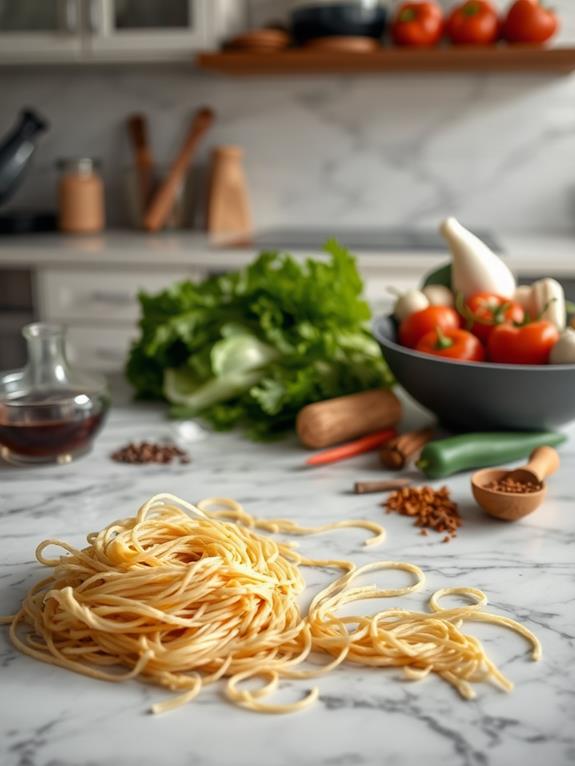
When considering raw ramen consumption, you'll find some notable nutritional differences compared to cooked noodles. While raw ramen may have fewer calories per serving, it's important to understand that nutrient absorption can be affected by the uncooked state. Additionally, when seasoning raw noodles, opting for high-quality salts like Diamond Crystal Kosher Salt can enhance flavor without the risk of over-salting due to its unique flake shape. You should also be aware of the sodium content, which remains high whether the noodles are cooked or not, potentially impacting your daily salt intake if consumed regularly.
Calorie Content Comparison
Calorie consciousness often drives snack choices, and raw ramen noodles present an intriguing option for those watching their intake. When you eat ramen in its uncooked form, you're consuming fewer calories compared to its prepared counterpart. Raw ramen typically contains between 190-400 calories per serving, while cooked versions can pack 400-600 calories. This significant difference makes raw ramen an attractive option for calorie-conscious snackers.
However, it's essential to understand that raw ramen's lower calorie content doesn't equate to better nutrition. The noodles are primarily carbohydrates with limited vitamins and minerals. To enhance the nutritional value while maintaining calorie control, consider these tips:
- Pair raw ramen with fresh vegetables for added nutrients
- Add a small portion of lean protein for balance
- Control portion sizes to avoid overconsumption
Nutrient Absorption Differences
Three key factors influence nutrient absorption when consuming raw ramen noodles. First, the absence of heat processing impacts how your body breaks down and utilizes the nutrients. When you're eating raw ramen, you're missing out on the benefits of cooking, which typically helps break down complex starches into more digestible forms. This means your body may not absorb as many nutrients from raw noodles compared to cooked ones.
Second, the lack of hydration in raw ramen affects digestion. Cooked noodles absorb water, making them easier for your digestive system to process. Without this hydration, raw noodles can be harder to digest, potentially causing discomfort and slowing down nutrient absorption.
Lastly, the nutritional profile of raw ramen is less balanced. While you'll consume more calories due to the higher density of uncooked noodles, you're missing out on the added nutrients typically found in a prepared dish. To improve the nutritional value when eating raw ramen, consider pairing it with fresh vegetables or proteins. This combination can help offset the lower nutrient absorption and provide a more balanced meal.
Sodium Intake Concerns
Raw ramen enthusiasts should be particularly mindful of sodium intake. When you eat a serving of instant ramen raw, you're likely consuming more sodium than if you prepared it as intended. This is because you're often sprinkling the seasoning directly onto the noodles, creating a concentrated flavor bomb. The sodium content in these seasoning packets can be alarmingly high, sometimes exceeding 800 milligrams per serving—that's a third of your daily recommended limit.
To enjoy Ramen Raw while managing your sodium intake, consider these tips:
- Use only a portion of the seasoning packet
- Opt for low-sodium varieties when available
- Balance your raw ramen snack with low-sodium foods throughout the day
Excessive sodium consumption can lead to health issues like high blood pressure and cardiovascular disease. It's essential to be aware of how much you're eating, especially when snacking on raw ramen. The convenience factor might tempt you to eat more than you realize, potentially pushing your sodium intake to unhealthy levels. By being conscious of portion sizes and seasoning use, you can still enjoy the crunchy texture of raw ramen while minimizing health risks associated with high sodium consumption.
Popular Raw Ramen Trends
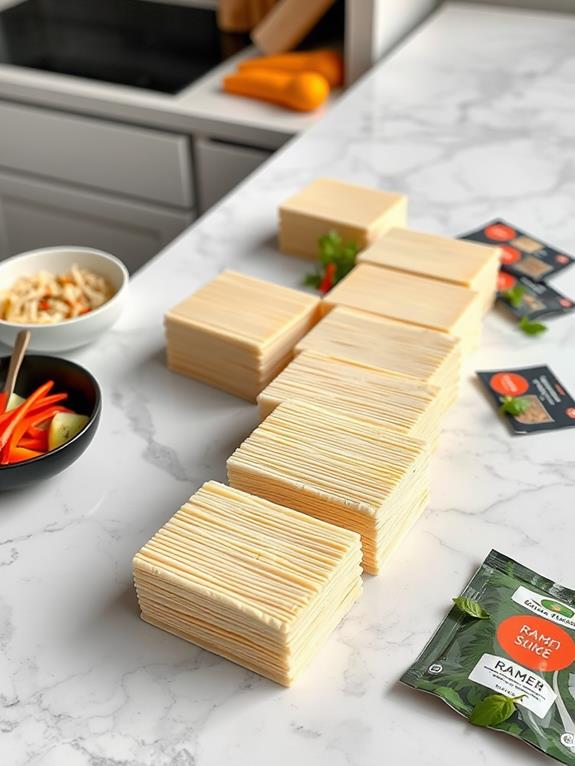
While once viewed as a last-resort meal for college students, raw ramen noodles have recently exploded in popularity on social media platforms. You'll find trendy videos on TikTok and Instagram showcasing crunchy snack hacks, with some garnering over 314,000 views. The hashtag #ramenhacks has become a go-to for food enthusiasts looking for innovative ways to enjoy uncooked ramen. Many creators are even pairing their raw ramen with unique seasonings and spices, like the Spice Way Star Anise, to enhance the flavor profile of their creations.
Influencers and home cooks are at the forefront of this trend, sharing unique variations that combine raw noodles with various toppings and seasonings. These creations often appeal to teenagers and young adults, tapping into a nostalgic desire for quick, easy snacks with an interesting texture.
The raw ramen trend isn't limited to traditional flavors. You'll encounter fusion recipes that incorporate elements from other cuisines, expanding the cultural significance of this simple ingredient. From spicy Korean-inspired versions to sweet dessert interpretations, the possibilities seem endless.
As you explore these trends, remember that while they're popular, it's crucial to reflect on the nutritional implications of consuming raw ramen regularly. The convenience and quirky appeal should be balanced with awareness of overall dietary needs.
Health Impacts of Uncooked Noodles
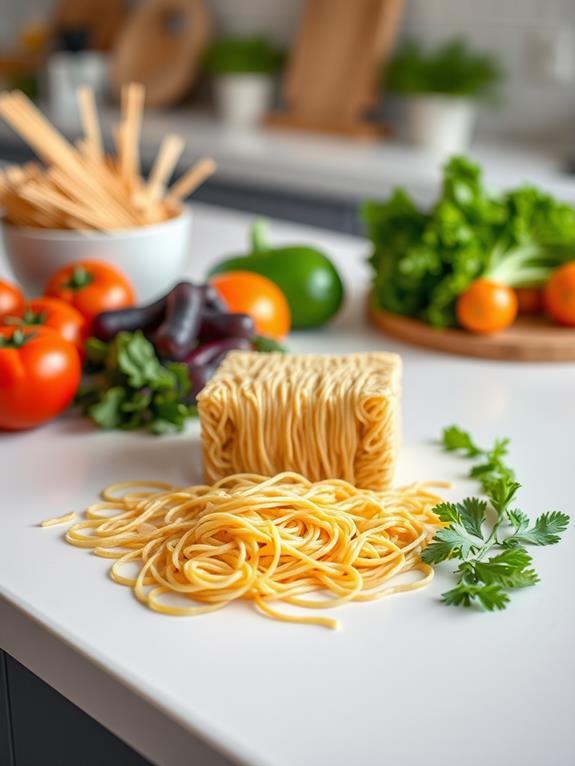
Despite the growing popularity of raw ramen as a snack, it's important to contemplate the health impacts of consuming uncooked noodles. While these pre-cooked and dehydrated noodles are safe to eat, they can be harder for your body to digest than their cooked counterparts. The higher fiber content in raw ramen might lead to digestive discomfort, especially if you're not used to it. quick, nutritious meal ideas can serve as healthier alternatives to raw ramen, offering more nourishment and flavors.
When you eat raw ramen, you're also exposing yourself to potential dental risks. The crunchy texture can be tough on your teeth, particularly if you have existing dental issues. Additionally, raw ramen is more calorie-dense than cooked noodles, which could contribute to weight gain if consumed excessively without proper nutritional balance.
Consider these points when deciding whether to indulge in raw ramen:
- It lacks the enhanced flavors and nutritional benefits of cooked ramen
- It may be less suitable as a regular part of your diet
- Cooking the noodles can improve their digestibility and overall nutritional value
While enjoying raw ramen occasionally isn't harmful, it's wise to be aware of these potential health impacts and consume it in moderation.
Alternative Preparation Methods
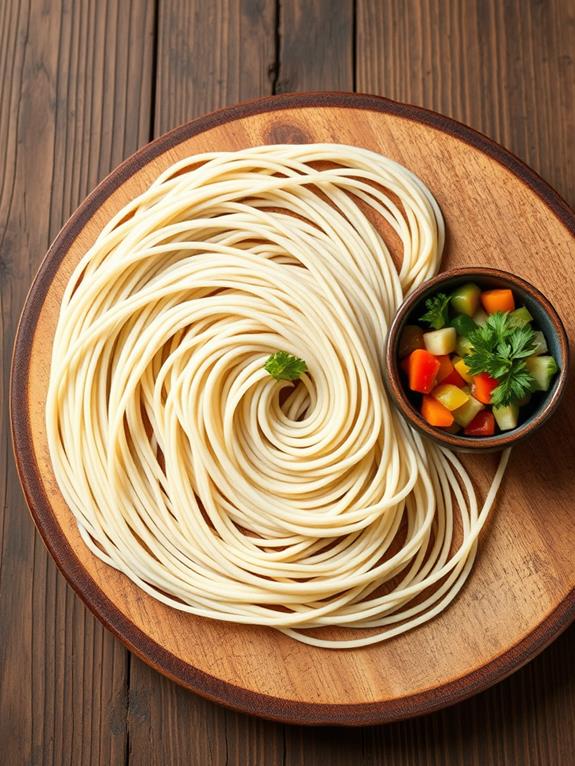
Now that we've explored the health impacts of raw ramen, let's consider some alternative preparation methods that can enhance your noodle experience. You'll find that instant ramen isn't limited to just boiling water. One popular method involves crushing the dry noodles, adding seasoning directly to the bag, and shaking it to create a crunchy snack. This no-cook option has gained traction on social media platforms, appealing to various demographics. For those who enjoy meal prepping, having the right containers such as Libbey Glass Prep Bowls can facilitate portion control and storage for your homemade ramen-inspired salads and snacks.
If you're looking for a healthier alternative, consider Immi Ramen, a low-carb, plant-based option that you can prepare quickly in boiling water or the microwave. This caters to those with specific dietary preferences while still offering convenience.
For a more creative approach, you can incorporate raw ramen into salads or fusion dishes. This versatility extends beyond conventional consumption, allowing you to experiment with different textures and flavors. While fresh ramen can be consumed raw, it's generally recommended to cook it for better safety and taste. Remember, raw fresh noodles lack seasoning and may cause digestive issues, so proceed with caution if you choose to eat them uncooked.
Moderation and Best Practices
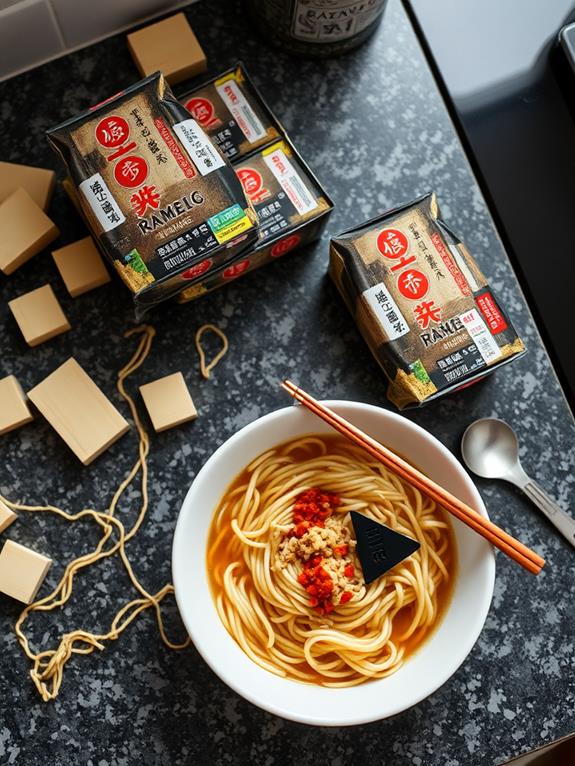
Enjoying raw ramen noodles can be a fun and convenient snack option, but it's vital to practice moderation and follow best practices. While consuming raw ramen is generally safe due to its pre-cooked and dehydrated nature, you should be mindful of a few key points. First, use only a moderate amount of the seasoning packet to avoid excessive salt intake. Additionally, it's crucial to think about how different snacks can affect your digestive health, similar to the precautions taken with perishable foods like chicken which should not be left out for extended periods safe food handling practices. Second, don't make raw ramen a regular part of your diet, as it offers limited nutritional value. Instead, treat it as an occasional crunchy snack.
To guarantee the best experience when eating raw ramen, contemplate these tips:
- Consume small portions to prevent digestive discomfort
- Store opened packages in a cool, dry place to maintain crunchiness and safety
- Experiment with alternative toppings or seasonings for added flavor and nutrition
Frequently Asked Questions
Is It Okay to Eat Ramen Raw?
You might worry about food poisoning, but it's okay to eat ramen raw. Raw ramen is pre-cooked and dehydrated, making it safe to consume. You'll find it's a popular crunchy snack in some countries. However, only eat from unopened packages to avoid moisture contamination. While it's safe, you may experience digestive discomfort, and the flavor won't be as rich as cooked ramen. It's a quick option when you can't prepare it hot, but consider your personal tolerance.
Is It Good to Eat Uncooked Noodles?
While it's technically safe to eat uncooked noodles, it's not necessarily good for you. You're missing out on the full flavor and nutritional benefits that come with cooking them. Eating raw noodles can be tough on your digestive system and may lead to discomfort. They're also less filling and potentially higher in calories than their cooked counterparts. If you enjoy the crunch, it's okay as an occasional snack, but it shouldn't become a regular habit for ideal health and enjoyment.
Are Ramen Noodles Safe to Eat?
Ramen noodles are like culinary chameleons, adapting to your cravings. They're safe to eat, whether cooked or raw. You can munch on them straight from the package as a crunchy snack, but be mindful of potential digestive issues if you overindulge. Cooking enhances their flavor and nutritional value, making it the preferred method. Remember, proper storage is key to maintain safety, especially after opening. Always check for signs of spoilage before consuming, and enjoy your ramen responsibly.
Can I Eat 2 Minute Noodles Raw?
Yes, you can eat 2 Minute Noodles raw. They're pre-cooked and dehydrated, making them safe to consume straight from an unopened package. You'll experience a unique crunchy texture that some people enjoy. However, once opened, be sure to eat them promptly to avoid moisture exposure. You can use the seasoning packet for added flavor, but use it sparingly to prevent excessive saltiness. While it's safe, cooking the noodles is generally recommended for better taste and digestibility.





